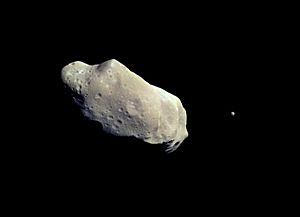243 Ida facts for kids

Galileo image of 243 Ida. The tiny dot to the right is its moon, Dactyl.
|
|||||||||||||
| Discovery | |||||||||||||
|---|---|---|---|---|---|---|---|---|---|---|---|---|---|
| Discovered by | Johann Palisa | ||||||||||||
| Discovery date | September 29, 1884 | ||||||||||||
| Designations | |||||||||||||
| A910 CD; 1988 DB1 | |||||||||||||
| Main belt (Koronis) | |||||||||||||
| Orbital characteristics | |||||||||||||
| Epoch October 22, 2004 (JD 2453300.5) | |||||||||||||
| Aphelion | 447.843 Gm (2.994 AU) | ||||||||||||
| Perihelion | 408.207 Gm (2.729 AU) | ||||||||||||
| 428.025 G m (2.861 AU) | |||||||||||||
| Eccentricity | 0.046 | ||||||||||||
| 1767.724 d (4.84 a) | |||||||||||||
|
Average orbital speed
|
17.60 km/s | ||||||||||||
| 245.469° | |||||||||||||
| Inclination | 1.138° | ||||||||||||
| 324.218° | |||||||||||||
| 108.754° | |||||||||||||
| Known satellites | Dactyl | ||||||||||||
| Physical characteristics | |||||||||||||
| Dimensions | 53.6×24.0×15.2 km | ||||||||||||
|
Mean radius
|
15.7 km | ||||||||||||
| Mass | 4.2×1016 kg 1 | ||||||||||||
|
Mean density
|
2.6 g/cm³ 1 | ||||||||||||
|
Equatorial surface gravity
|
0.0109 m/s² | ||||||||||||
|
Equatorial escape velocity
|
0.0185 km/s | ||||||||||||
| 0.1931 d (4 h 37 min) 2 | |||||||||||||
| 0.2382 3 | |||||||||||||
|
|||||||||||||
| S | |||||||||||||
| 9.94 | |||||||||||||
243 Ida is a space rock, also known as an asteroid, that orbits the Sun in the main asteroid belt. It became famous when the Galileo spacecraft took pictures of it on August 28, 1993. Ida was the first asteroid ever found to have its own moon. It is part of a group of asteroids called the Koronis family.
Contents
Finding Ida and Its Name
Ida was discovered by an astronomer named Johann Palisa. He found it on September 29, 1884, while working in Vienna.
The asteroid was named after Ida, a Cretan nymph from Greek mythology. She was said to live on a mountain that shares her name, Mount Ida, Crete.
Ida's Moon: Dactyl
Ida has a tiny moon called Dactyl. This moon was discovered on February 17, 1994. Ann Harch, a member of the Galileo mission team, found it while looking at images sent back from the spacecraft.
The moon was first called S/1993 (243) 1. Later, it was officially named (243) Ida I Dactyl. The pictures where Dactyl was first seen were taken on August 28, 1993.
How Big is Dactyl?
Dactyl is very small, only about 1.4 km across. Scientists have different ideas about how Dactyl formed.
- Some think it might have broken off from Ida. This could happen if another space rock crashed into Ida, sending debris flying.
- Others believe Ida and Dactyl formed together. They might have been a pair for a very long time, perhaps billions of years. This would have happened when a larger space body that Ida came from broke apart.
Scientists are still working to figure out which theory is correct. Since Dactyl was found, many other asteroids have also been found to have moons. This shows that asteroid moons might be quite common in space.
Ida's Shape and Spin
Ida is not perfectly round. It's shaped more like a potato or a peanut. Its longest side is about 53.6 km, and its shortest side is about 15.2 km.
Because Ida has a moon, scientists could figure out its mass. This helped them understand its gravity. The gravity on Ida's surface is very weak, much weaker than on Earth. Ida also spins quite fast, completing a full rotation in about 4 hours and 37 minutes.
Related Space Objects
Images for kids
See also
 In Spanish: (243) Ida para niños
In Spanish: (243) Ida para niños







